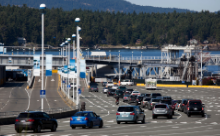 Transportation accounts for more than half of our community’s greenhouse gas emissions. Changing the way we move around is key to mitigating our greenhouse gas emissions and reducing the worst impacts of climate change.
Transportation accounts for more than half of our community’s greenhouse gas emissions. Changing the way we move around is key to mitigating our greenhouse gas emissions and reducing the worst impacts of climate change.
Transportation and carbon
Choosing to travel on foot, by bike, or by bus not only helps to reduce our emissions, but also improves local air quality, reduces traffic congestion, is more affordable, and is healthy for us. Active transportation is the most environmentally friendly choice.
Transitioning from fossil fueled vehicles to electric and other low-emission vehicles also plays a role. Local and senior levels of government have enacted policies to encourage and require this important transition. The Zero-Emission Vehicles (ZEV) Act, passed by the provincial government, requires automakers to sell more ZEVs each year. By 2040, all new light-duty vehicle sales will be zero-emission vehicles.
We can also reduce our transportation emissions by choosing to take vacations locally. There is a lot to explore right here in our region!
Choosing to walk, bike, or take public transit to significantly reduce your greenhouse gas emissions! It is also good for your health and can save money on gas and parking.
With no tailpipe, battery electric vehicles (EVs) produce no harmful greenhouse gases, which are bad for air quality and the climate. They also save you money over the lifetime of the vehicle with significantly lower fuel and maintenance costs.
Rebates & Incentives
Looking to make your next vehicle an electric one? Want to install a charger in your house or building? Plug In BC provides a central source for information rebates and incentives that will support our community in its transition to electric vehicles. Read more >>
BC SRAP-IT Program includes incentives to replace higher polluting vehicles with new or used EVs or E-bikes. Read more >>
Live in or manage a condo or apartment building? The Multi-Unit Residential Building Charging Program provides incentives and support for installing charging stations for multi-dwelling buildings. Read more >>
As part of our commitment to reduce greenhouse gas (GHG) emissions within corporate operations, the CRD is undertaking a Zero Emissions Fleet Initiative (ZEFI), within its vehicle fleet. Read more >>
Resources for fleet owners:
- Many BC fleets are going electric. Plug-in electric vehicles can save substantial money on fuel, reduce maintenance costs, and improve an organization’s environmental impact. Read more >>
- West Coast Electric Fleets is an initiative of the Pacific Coast Collaborative (PCC), a joint initiative of California, Oregon, Washington, and British Columbia to accelerate the adoption of zero-emissions vehicles in public and private fleets. Read more >>